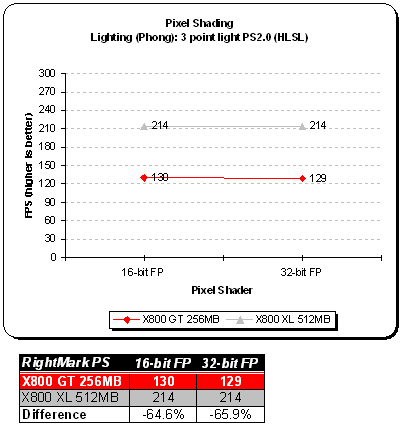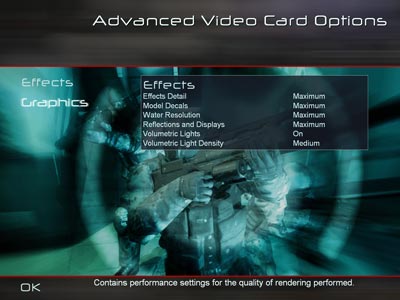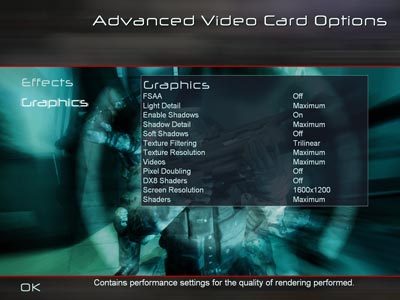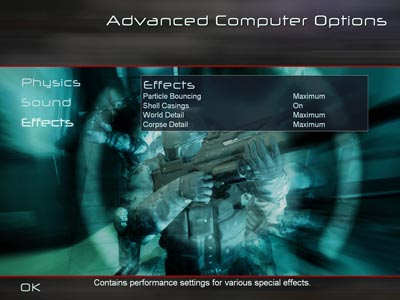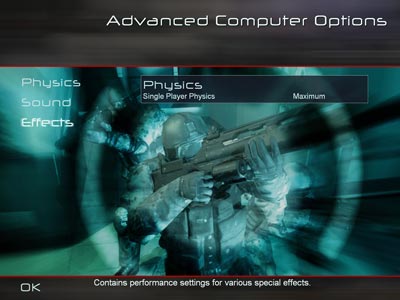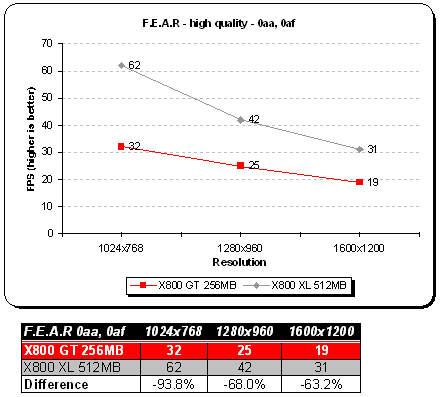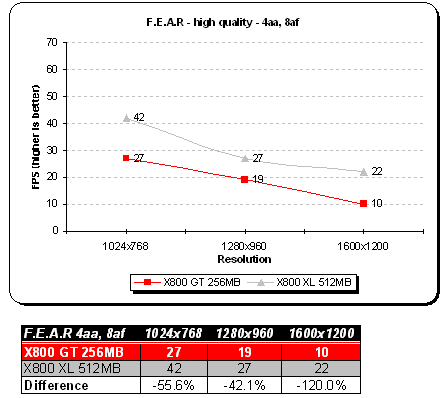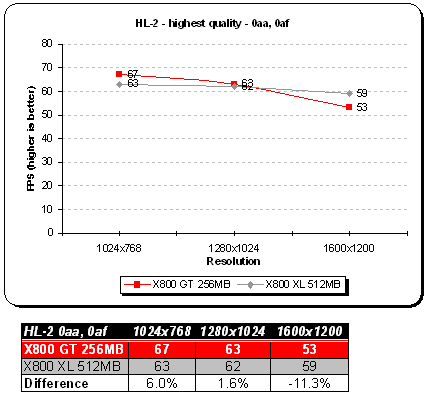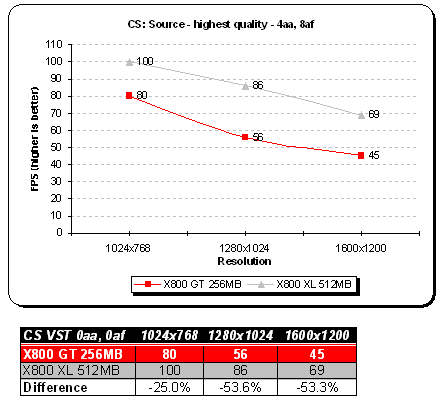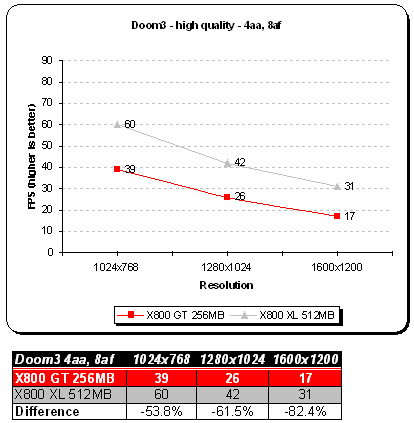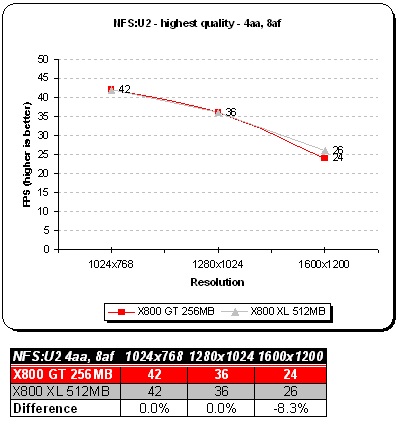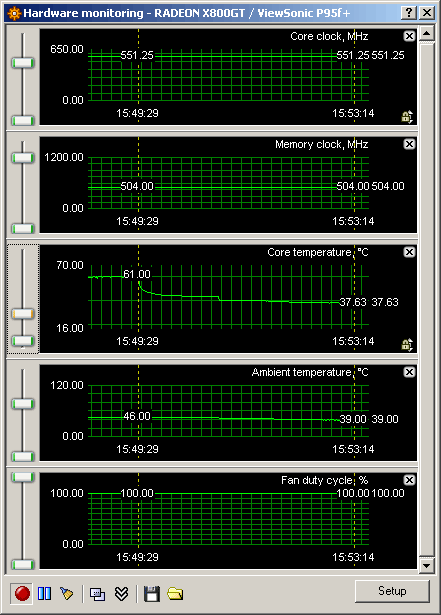I have drawn plenty of facts from testing ATI’s latest VPU, RADEON X800 GT. PowerColor X800 GT is a beast in its own class. Thanks to very high core and memory clocks the performance of an 8 pipeline card is as good as it will ever get. We show you how to bump a 475 MHz core beyond X850 XT PE’s with just few minutes resulting in a massive 551 MHz overclock. The beauty of RADEON X800 GT is its R480 core. Though cut down to 8 pixel pipelines, you get great performance at a reasonable price. You won’t get a better deal for $159 USD (256 MB version), but if you think that’s too much consider a 128 MB model for $139 USD.
Introduction
Today ATI is launching a brand new RADEON® graphic card the X800 GT. This particular VPU is targeted at NVIDIA’s GeForce 6600GT and 6800LE series of cards. ATI’s partners will supply roughly 50,000 units during the launch month which means there will be quite a lot of X800 GTs available. While testing the card I talked to Andrzej Bania — PR and Marketing Manager for Northern Europe & South Africa. We spoke about X800 GT and how it will impact ATI’s current line of products. You might recall X700 XT which was a direct competitor to GeForce 6600GT, unfortunetely ATI decided to can it in favor of a more powerful X800.
Andrzej Bania (ATI): X700XT was moved out because we could bring the price of X800 down to compete with the 6600GT, but – whenever possible – we don’t wish to simply compete. We aim to win and win big!
Obviously X800 GT might be based on one of the three cores: R420, R423 and R480. Can it be that some customers will get a better core than the others? I’m sure ATI has chosen chips with better yields and Tul Corporation, the maker of PowerColor graphic cards has specifically stated that their product is built around R480 ASIC. Time will show what other IHVs will ship, but I’m guessing it’s the same. As for yields, here is what Andrzej had to say:
Andrzej Bania (ATI): Production have not been an issue on any product since R420 – getting enough time with the software development teams can be a much greater challenge. As our revenue keeps increasing – so we are constantly re-gearing for greater demand.
Our gem today will be PowerColor X800 GT equipped with 256 MBs of GDDR3 RAM sporting 256-bit memory interface.
PowerColor is a consumer brand focused on providing cutting-edge graphics card products to retail customers. Our goal for the Tul brand is to be the industry’s number one provider of technology product solutions. Our goal for the PowerColor brand is to be the world’s number one brand of graphics cards. PowerColor is in effect owned by Tul Corporation, however the brands are operated independently of each other.
VPU Specifications
As I have mentioned on the first page, PowerColor X800 GT is based on R480 core. Are those scrap silicons with two non working quads? Or maybe they are fully operational X850 VPUs? The obvious differences are clock speeds and number of pixel pipelines which put this card in the middle-end sector. Framebuffer is equal to that found on X850 XT PE, X800 PRO and Bravo X700. ATI Tray Tools report the VPU clock of 472 MHz (68 MHz less than X850 XT PE) and memory at 985 MHz effective DDR which gives us theoretical bandwidth of 31.5 GB / sec. Please note that clocks from the table below are taken from GT’s BIOS.

| PowerColor |
X800 GT
|
X850 XT PE
|
X800 XL 512MB
|
X800 PRO LAE
|
Bravo X700
|
| VPU (256-bit) |
R480
|
R481
|
R430
|
R420
|
RV410
|
| Chip Architecture |
.13µ low-k (TSMC fab)
|
.13µ low-k (TSMC fab)
|
.11µ (TSMC fab)
|
.13µ low-k (TSMC fab)
|
.11µ (TSMC fab)
|
| Transistors |
~160 Million
|
~160 Million
|
~160 Million
|
~160 Million
|
~120 Million
|
| Memory Architecture |
256-bit
|
256-bit
|
256-bit
|
256-bit
|
128-bit
|
| Frame Buffer Size |
256 MB GDDR-3
|
256 MB GDDR-3
|
512 MB GDDR-3
|
256 MB GDDR-3
|
256 MB GDDR-2
|
| Pixel Pipelines |
8
|
16
|
16
|
12
|
8
|
| Vertex Pipelines |
6
|
6
|
6
|
6
|
6
|
| TMU(s) per Pipeline |
1
|
1
|
1
|
1
|
1
|
| Engine |
SMARTSHADER HD
|
SMARTSHADER HD
|
SMARTSHADER HD
|
SMARTSHADER HD
|
SMARTSHADER HD
|
| Bus Type |
PCI-e 16x
|
AGP 8x, 4x
|
PCI-e 16x
|
AGP 8x, 4x
|
PCI-e 16x
|
| Core Clock |
475 MHz
|
540 MHz
|
400 MHz
|
475 MHz
|
400 MHz
|
| Memory Clock |
980 MHz DDR
|
1180 MHz DDR
|
980 MHz DDR
|
900 MHz DDR
|
532 MHz DDR
|
| RAMDACs |
2x 400 MHz DACs
|
2x 400 MHz DACs
|
2x 400 MHz DACs
|
2x 400 MHz DACs
|
2x 400 MHz DACs
|
| Memory Bandwidth |
31.4 GB / sec
|
37.6 GB / sec
|
31.4 GB / sec
|
28.8 GB / sec
|
8.5 GB / sec
|
| Pixel Fillrate |
3.8 GPixels / sec
|
8.6 GPixels / sec
|
6.4 GPixels / sec
|
5.7 GPixels / sec
|
3.2 GPixels / sec
|
| Texel Fillrate |
3.8 GTexels / sec
|
8.6 GTexels / sec
|
6.4 GPixels / sec
|
5,7 GTexels / sec
|
3.2 GPixels / sec
|
| DirectX Version |
9.0c
|
9.0c
|
9.0c
|
9.0c
|
9.0c
|
| Pixel Shader |
2.0b
|
2.0b
|
2.0b
|
2.0b
|
2.0b
|
| Vertex Shader |
2.0
|
2.0
|
2.0
|
2.0
|
2.0
|
SMARTSHADER™ HD
- Support for Microsoft® DirectX® 9.0 programmable vertex and pixel shaders in hardware
- DirectX® 9.0 Vertex Shaders
- Vertex programs up to 65,280 instructions with flow control
- Single cycle trigonometric operations (SIN & COS)
- DirectX® 9.0 Extended Pixel Shaders
- Up to 1,536 instructions and 16textures per rendering pass
- 2nd generation F-buffer technology accelerates multi-pass pixel shader programs with unlimited instructions
- 32 temporary and constant registers
- Facing register for two-sided lighting
- 128-bit, 64-bit & 32-bit per pixel floating point color formats
- Multiple Render Target (MRT) support
- Complete feature set also supported in OpenGL® via extensions
SMOOTHVISION™ HD
- 2x/4x/6x Anti-Aliasing modes
- Sparse multi-sample algorithm with gamma correction, programmable sample patterns, and centroid sampling
- Lossless Color Compression (up to6:1)at all resolutions, including widescreen HDTV resolutions
- Temporal Anti-Aliasing
- 2x/4x/8x/16x Anisotropic Filtering modes
- Up to 128-tap texture filtering
- Adaptive algorithm with bilinear (performance) and trilinear (quality) options
3Dc™
- High quality 4:1 Normal Map Compression
- Works with any two-channel data format
HYPER Z™ HD
- 3-level Hierarchical Z-Buffer with Early Z Test
- Lossless Z-Buffer Compression (up to 48:1)
- Fast Z-Buffer Clear
- Z Cache optimized for real-time shadow rendering
- Optimized for performance at high display resolutions, including widescreen HDTV resolutions
VIDEOSHADER™ HD
- Seamless integration of pixel shaders with video in real time
- FULLSTREAM™ video de-blocking technology for Real, DivX, and WMV9 formats
- VIDEOSOAP™ noise removal filtering for captured video
- All-format DTV/HDTV decoding
- Adaptive Per-Pixel De-Interlacing and Frame Rate Conversion (temporal filtering)
DISPLAY FEATURES
- Dual integrated display controllers
- Dual integrated 10 bit per channel 400 MHz DACs
- Integrated 165 MHz TMDS transmitter (DVI 1.0 / HDMI compliant and HDCP ready)
- Integrated TV Output support up to 1024×768 resolution
- YPrPb component output for direct drive of HDTV displays†
- Single and dual link external TMDS transmitter support for high resolution and/or multi-monitor DVI configurations
- Compatible with ATI’s THEATER™ video decode and capture devices for VIVO (Video Input / Video Output) configurations on certain X800 graphic cards
ADDITIONAL FEATURES
- Windows® Logo Program compliant
- CATALYST™ Software Suite
In terms of feature set, there are no major differences from R300 / R350 VPUs, except for improved pixel / vertex shader instructions and additional map compression.
The Card
Last month we’ve reviewed PowerColor X800 XL which was equipped with 512 MBs of GDDR3 RAM. If you remember the card sported SCS2 heatpipe system. Although we don’t have anything fancy in terms of heat dissipation, we have a great card in our lab which deserves your attention.

Click on the picture to enlarge
Click on the picture to enlarge
Click on the picture to enlarge
Click on the picture to enlarge
Click on the picture to enlarge
Click on the picture to enlarge
Click on the picture to enlarge
Click on the picture to enlarge
Click on the picture to enlarge
In terms of package and bundle you’ll find a standard PowerColor box with accessories and software. The box looks similar to PowerColor’s X800 XL 512MB in terms of design — same angel, just different color scheme. You won’t find any super new games inside the box. PowerColor includes Pacific Fighters along with CyberLink DVD Solutions. Let’s move into some other details.
Click on the picture to enlarge
Click on the picture to enlarge
Click on the picture to enlarge
Click on the picture to enlarge
Click on the picture to enlarge
Here we have software along with the rest of the bundle. Complete list of what Tul bundles with their PowerColor X800 GT graphic card:
- Accessories
- S-Video Cable
- Composite Cable
- DVI-I Connector
- User’s Manual
-
Software bundle
- Driver CD
- CyberLink DVD Solutions
- PowerDVD 5
- PowerProducer 2 Gold DVD
- PowerDirector 3
- Power2Go 3
- Medi@show 2
- Pacific Fighters full game
- Pacific Fighters multilanguage hot-key reference guide
Setup and Installation
All of our benchmarks were ran on Athlon64 3000+ system with default clock speed. I will be comparing our PowerColor X800 GT 256 MB to other PowerColor X800 XL 512 MB we reviewed back in June. The table below shows test system configuration as well benchmarks used throughout the review.
| Components | – DFI NF4 Ultra-D – Athlon64 3000+ Venice – 2x256MB Corsair PC3200LLP (Dual Channel) – Chaintech 420 Watt PSU – PowerColor X800 GT 256 MB – PowerColor X800 XL 512 MB |
| Software | – Windows XP SP2 – DirectX 9.0c – nForce4 6.53 drivers – Supplied CATALYST 5.7 |
| Synthetic Benchmarks | – 3DMark 2005 v1.2.0 – D3D Right Mark 1.0.5.0 beta 4 |
| Gaming Benchmarks | – F.E.A.R (demo) / Fraps – Half-Life 2 / custom d13c17 timedemo – CS: Source VST – Doom 3 / default timedemo – Far Cry 1.32 / custom timedemo – NFS: Underground 2 / Fraps |
| Notes | CPU was clocked at default 1.8GHz |
Drivers I received from Tul were CATALYST 5.7 though different build it seems:

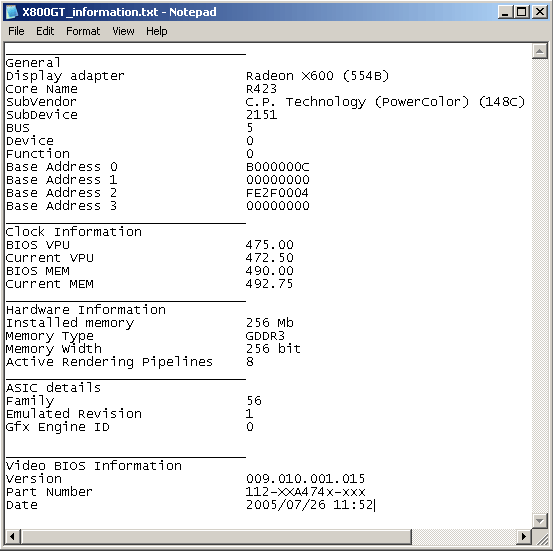
As far as installation goes, I haven’t had any problems fitting the card in or anything like that. For the game benchmarks, I’ve decided to expand my arsenal and added F.E.A.R, Counter-Strike: Source Video Stress Test and Far Cry patched to version 1.32. With synthetic testing, nothing had changed, you’ll see standard 3DMark 2005 game test scores along with T&L / shader performance output from D3D Right Mark.

Synthetic Benchmarks
3DMark05
| PowerColor |
X800 GT 256MB
|
X800 XL 512MB
|
X850 XT PE
|
X800 PRO LAE
|
| Pixel Fillrate |
2705,8 MPixels / sec
|
3037,2 MPixels / sec
|
3654,3 MPixels / sec
|
2726,7 MPixels / sec
|
| Texel Fillrate |
3774,6 MTexels / sec
|
6332,3 MTexels / sec
|
8542,8 MTexels / sec
|
5707,4 MTexels / sec
|
| Geometry Rate |
475 MTriangles
|
400 MTriangles
|
540 MTriangles
|
475 MTriangles
|
| Vertex Shader – Simple |
48,1 MVertices / sec
|
55,6 MVertices / sec
|
62,1 MVertices / sec
|
50,7 MVertices / sec
|
| Vertex Shader – Complex |
40,7 MVertices / sec
|
37,1 MVertices / sec
|
49,7 MVertices / sec
|
44,1 MVertices / sec
|
| Pixel Shader (2.0b) |
74,5 FPS
|
123,1 FPS
|
154,6 FPS
|
104,4 FPS
|
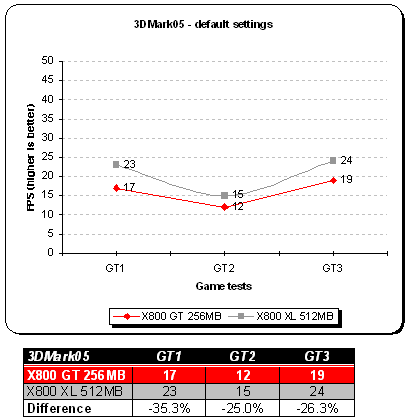
RightMark
D3D RightMark is a very useful tool for measuring different theoretical throughputs of a graphics chip. I ran couple of synthetic tests to stress out our PowerColor X800 XL and stacked it against PowerColor X850 XT PE and X800 PRO too see how it managed in Geometric Processing (Vertex Shading) as well as Pixel Shading tests.
With D3D RightMark you will be able to get the following information about your video card:
- Features supported by your video card
- Pixel Fillrate and Texel Fillrate
- Pixel shader processing speed (all shader models)
- Vertex shader (geometry) processing speed (all shader models)
- Point sprites drawing speed
- HSR efficency
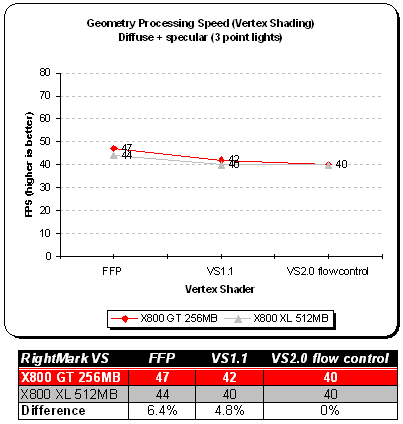
As you can see, there is a ~6% difference (in favor of the GT of course) between X800 GT and X800 XL when it comes to Fixed Function Pipeline (FFP). Note that FFP mode is stressing standard Transform & Lightning pipeline whereas VS1.1 and VS2.0 are stressing the geometry processing pipeline (vertex pipeline). Surprisingly, our PowerColor X800 GT performed better in VS 1.1 producing 42 FPS and on par with the XL during the VS 2.0 run.
F.E.A.R
Last Friday, exactly at 1 PM EST (August 5th), VUGames have released F.E.A.R demo to the public. The game is being made over at Monolith Productions studio and should be out later this year. Since almost everyone has been waiting for this demo, I’ve decided to give it a shot and bench it with our X800 GT.
F.E.A.R demo suffers from serious on the fly texture caching which means whenever you turn around the whole system will chug until all textures are loaded. Let’s hope this syndrome will be significantly reduced in the retail version. To give more accurate results, all benchmarks were performed after all textures were cached in.
Game Overview
An unidentified paramilitary force infiltrates a multi-billion dollar aerospace compound, taking hostages but issuing no demands. The government responds by sending in special forces, but loses contact as an eerie signal interrupts radio communications. When the interference subsides moments later, the team has been obliterated. As part of a classified strike team created to deal with threats no one else can handle, your mission is simple: Eliminate the intruders at any cost. Determine the origin of the signal. And contain the crisis before it spirals out of control.
As you probably know, F.E.A.R uses a very sophisticated game engine (FEAR).
- Rendering
- FEAR is powered by a new flexible, extensible, and data driven DirectX 9 renderer that uses materials for rendering all visual objects. Each material associates an HLSL shader with artist-editable parameters used for rendering, including texture maps (normal, specular, emissive, etc.), colors, and numeric constants.
- Lightning Model
- FEAR features a unified Blinn-Phong per-pixel lighting model, allowing each light to generate both diffuse and specular lighting consistently across all solid objects in the environment. The lighting pipeline uses the following passes:
- Emissive: The emissive pass allows objects to display a glow effect and establishes the depth buffer to improve performance.
- Lighting: The lighting pass renders each light, first by generating shadows and then by applying the lighting onto any pixels that are visible and not shadowed.
- Translucency: The translucent pass blends all translucent objects into the scene using back to front sorting.
- FEAR features a unified Blinn-Phong per-pixel lighting model, allowing each light to generate both diffuse and specular lighting consistently across all solid objects in the environment. The lighting pipeline uses the following passes:
- Visual Effects
- FEAR features a new optimized, data driven effects system that allows for the creation of key-framed effects that can be comprised of dynamic lights, particle systems, models, and sounds. Examples of the effects that can be created using this system include weapon muzzle flashes, explosions, footsteps, fire, snow, steam, smoke, dust, and debris.
- Sample Lights
- FEAR’s lighting model is very flexible and allows developers to easily add new lights. Existing lights include:
- Point Light: The point light is a single point that emits light equally in all directions.
- Spotlight: Similar to a flashlight, the spotlight projects light within a specified field of view. The spotlight can also use a texture to tint the color of the lighting on a per pixel basis.
- Cube Projector: Similar to the point light, the cube projector uses a cubic texture to tint each lit pixel.
- Directional Light: This lighting is emitted from a rectangular plane and is used to simulate directional lights like sunlight.
- Point Fill: Although similar to the point light, the point fill is an efficient option because it does not utilize specular lighting or cast shadows.
- FEAR’s lighting model is very flexible and allows developers to easily add new lights. Existing lights include:
A more detailed overview of other F.E.A.R technologies can be found over at Touchdown Entertainment. These include: Havok Physics Engine and Modeling / Animations System.
Above we have screenshots from the game’s performance menu. With everything maxed out (set to maximum), average FPS was around 15 FPS at 1024×768 so it made no sense to bench it that way. Instead, video card options as well as computer settings were set to high — only soft shadows were turned off and volumetric light was nocked down to medium. That gave us more satisfactory scores.
Even at lower resolution (1024×768) and all textures cached the GT just doesn’t seem to cut it. This title is very shader intensive, not to mention volumetric lights which are used all over the place. This is a demo so I expect big improvements in the retail version. I wonder if the additional 256 MBs on the XL help out because texture caching was much faster and chugging wasn’t so visible.
When 4x Antialiasing and 8x Anisotropic Filtering is enabled, X800 GT scores 27 FPS at 1024×768 — roughly 56% less than XL which ended up with 42 FPS. With higher resolutions there is plenty of stuttering which makes the game unplayable. It seems that every setting maxed out is a bit of an overkill for 8 pipeline card.
Half-Life 2
We all love Half-Life 2 and we all want best performance out of our hardware. This has to be one of the most graphic demanding games currently on the market. Half-Life 2 is built around Source engine which utilizes a very wide range of DirectX 8 / 9 special effects. Those include:
- Diffuse / specular bump mapping
- Dynamic soft shadows
- Localized / global valumetric fog
- Dynamic refraction
- High Level-of-Detail (LOD)
Note that users with DirectX 7 and older hardware (NVIDIA MX series for example) will not be able to enjoy the above effects. Let’s see what X800 XL is made of.
I have benched Half-Life 2 using HardwareOC Half-Life 2 Benchmark tool and their custom d13c17 demo. At 1024×768 PowerColor X800 GT beats the higher-end cousin by 6%! Even with higher resolutions GT doesn’t give up and end up with 53 FPS at 1600×1200 — only 11% less than XL.
Now when we enable 4x AA and 8x AF, we have a different situation. It seems there is a quite of a performance hit for the GT across all resolutions. It’s understandable since most of the fillrate is killed and there isn’t a lot of it to play with anyway. Also, X800 GT has 8 pixel pipelines while XL has 16.
CS: Source VST
Albeit you’ve seen how Source engine performs with Half-Life 2, I decided to throw in additional performance scores from Counter-Strike: Source’s Video Stress Test. The fantastic thing about this benchmark is it uses most if not all of the following special effects:
- Diffuse / specular bump mapping
- Dynamic soft shadows
- Localized / global valumetric fog
- Dynamic refraction
- High Level-of-Detail (LOD)
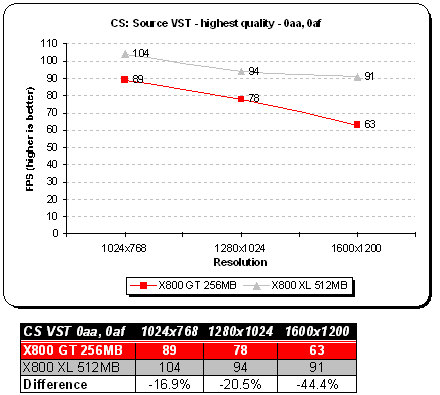
Doom 3
Now that we are past Doom 3s release, some gamers have been left with a bit of disappointment. Main reason is Half-Life 2 and its Source engine which really showed a vast amount of potential and scalability.
Although this game needs no introduction, I will go over some of the game features and technology behind Doom 3. It took the guys at id Software over four years to complete this project. Lead programmer, John Carmack spent an awful lot of time designing the game engine, but his hard work paid off — to some extent since this is first title which houses Doom 3 engine.
Let’s look at some of the engine tech features which are present in Doom 3:
- Unified lightning and shadowing engine
- Dynamic per-pixel lightning
- Stencil shadowing
- Specular lightning
- Realistic bumpmapping
- Dynamic and ambient six-channel audio
However you look at it, Carmack’s lightning engine is the essence of Doom 3. With OpenGL being the primary API, shaders have been put to a heavy use in order to create the realisticly looking environment. Instead of using lightmaps the game engine now processes all shadows in real-time. This technique is called stencil shadowing which can accurately shadow other objects in the scene. There are disadvantage to this method however:
- Requires a lot of fillrate
- Fast CPU is needed for shadow calculations
- Inability to render soft shadows
CATALYST drivers had improved greatly since Doom 3 introduction. There were some issues and stuttering with early drivers, but it looks like CATALYST team has been ironing things out.
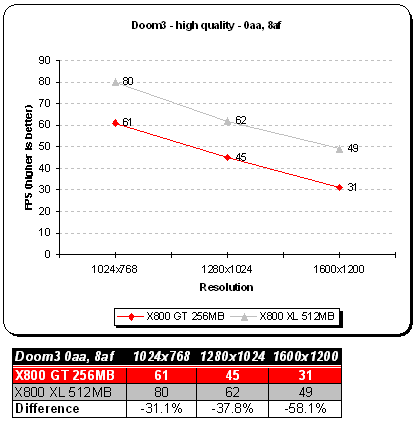
Need For Speed: Underground 2
Another DirectX 9 title with nicely shaped up graphics. The neverending title from EA Sports has brought many plenty of fun as with previous NFS series. The game uses various effects mostly found in Shader Model 2.0 such as motion blur, light / glow trails or reflections. The good thing is, all those effects are compatible when Antialiasing is enabled.
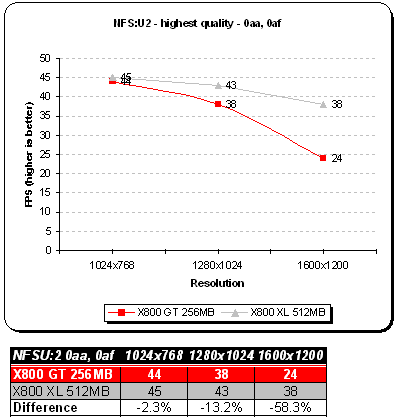
Far Cry 1.32
The company behind this game is Crytek. It was pretty much the first title which used a heavy load of PS 2.0 shaders. For our benching purposes we are using the full version with the newest 1.32 patch applied (mainly fixes SM 3.0 issues that caused graphic corruption on newer ATI hardware). Anyone who played this title will admire the draw distance, beautiful outside vegetation and incredibly spooky indoor environment. The game also features topnotch self-learning A.I and very realistic physics.
Far Cry’s CryEngine is pretty scalable, however you’d need at least DirectX 8 class hardware to enjoy the refractive water effects, ripples, real time per-pixel lighting, specular bump-mapping or volumetric effects.
The map of choice was Research. It’s a high-polygon map with both outdoor and indoor environment.
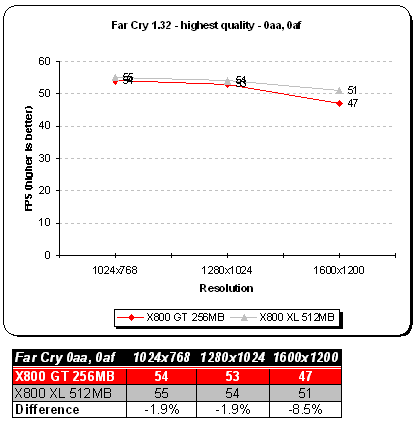
PowerColor X800 GT does an average of 54 FPS at 1024×768. The gameplay was smooth without major slowdowns. At 1280×1024, XL is only better by ~2%. Higher resolution shows a loss of 8.5%.

I recommend setting 4x AA and 8x AF with the GT for the first two resolutions. We get a smooth 49 and 37 FPS which is playable at that rate. With 1600×1200 we get below 30 FPS which is ~52% less frames than with XL. High resolutions and combined AA/AF degrades performance almost in half!Overclocking and Temperatures
Because PowerColor X800 GT is based on R480 VPU, one would expect it to overclock well — at least the core since the memory chips differ from those on X850. On the GT model we have 8 memory modules. They are SAMSUNG K4J55323QF-GC20: 256-bit architecture, uBGA 144 package and rated at 500 MHz (1000 MHz effective DDR) with the speed of 2.0 ns. Pretty impressive since X800 GT’s memory is already clocked at 485 MHz. Can we reach the magical 500 MHz mark?

Room temperature: 20C, default clocks, fan 100%, load:
Okay, first the core. I have created a log in which I reported clock speeds, artifact information as well as stability. Both core and memory logs are supported with hardware monitor readings.
Core log 1: 490 MHz, no artifacts for 120 seconds — still going, stable
Core log 2: 495 MHz, no artifacts for 120 seconds — still going, stable
Core log 3: 500 MHz, no artifacts for 120 seconds — still going, stable
Core log 4: 505 MHz, no artifacts for 120 seconds — still going, stable
Core log 5: 510 MHz, no artifacts for 120 seconds — still going, stable
Core log 6: 515 MHz, no artifacts for 120 seconds — still going, stable
Core log 7: 520 MHz, no artifacts for 120 seconds — still going, stable
Core log 8: 525 MHz, no artifacts for 120 seconds — still going, stable
Core log 9: 530 MHz, no artifacts for 120 seconds — still going, stable
Core log 10: 535 MHz, no artifacts for 120 seconds — still going, stable
Core log 11: 540 MHz, no artifacts for 240 seconds — still going, stable (This is default core clock for X850 XT PE!)
Core log 12: 545 MHz, no artifacts for 240 seconds — still going, stable
Core log 13: 551 MHz, no artifacts for 240 seconds — still going, stable
Core log 14: 555 MHz, 3 artifacts found during 40th second — unstable
Core log 15: 554 MHz, 1 artifact found during 55th second — unstable
Core log 16: 551 MHz, no artifacts for 240 seconds — stable
Let’s check out what we can squeeze out of memory chips.
Memory log 1: 495 MHz, no artifacts for 120 seconds — still going, stable
Memory log 2: 500 MHz, no artifacts for 120 seconds — still going, stable
Memory log 3: 505 MHz, 4 artifacts found during 36th second — unstable
Memory log 4: 504 MHz, no artifacts for 240 seconds — stable
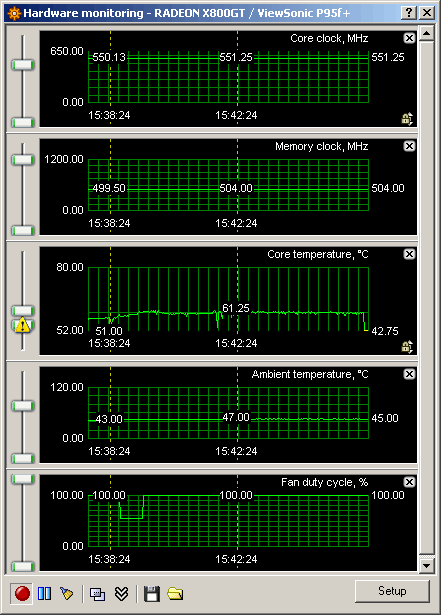
Room temperature: 20C, maximum core / memory overclock, fan 100%, idle:
3DMark05 OC results
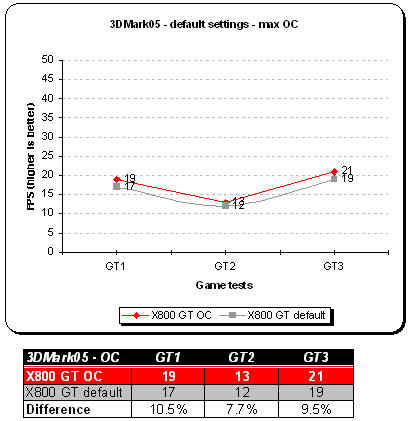
Conclusions
I have drawn plenty of facts from testing ATI’s latest VPU, RADEON X800 GT. PowerColor X800 GT is a beast in its own class. Thanks to very high core and memory clocks the performance of an 8 pipeline card is as good as it will ever get. If you look back at the previous page, we showed you how to bump a 475 MHz core beyond X850 XT PE’s with just few minutes resulting in a massive 551 MHz overclock. That’s right, you heard me. I managed to overclock PowerColor X800 GT to those speeds, running stable and artifact free. Even though X800 GT carries memory chips that are almost maxed out on frequency, we get a whopping core overclock which makes a quite an impact in todays games. Let’s just hope every retail X800 GT will overclock like our PowerColor sample. The only gripe I have with the RADEON X800 GT is that it’s late in the game. This particular product should have been out months ago. Sure it’s fast and performs really well, but the fact is NVIDIA will be releasing new GeForce 7800 model(s) soon and this card’s life span will be short.
The price of the GT won’t be high and it will be available in both 128 MB and 256 MB versions. Should you want to build el-cheap’o Small Form Factor PC or Home Theater system, RADEON X800 GT is the way to go — especially from PowerColor. It packs features that are available with high-end cards (maybe except Video-in) and provides reasonable frame rates in newest games. As far as ‘Crossfiring’ X800 GT with another RADEON goes, ATI does not have a solid answer to that question. What I think it means is either the card lacks crossfire support or this feature is not yet ready.
Andrzej Bania (ATI): At the price points we are targetting, X800 GT blows 6600GT out of the water and even beats the much more expensive 6800 in many cases.
Andrzej Bania (ATI): End users do not need to worry about ‘How can ATI make such a powerful card available’ they just need to sit back and enjoy the performance.
In the end, RADEON X800 GT’s beauty is its R480 core. Though cut down to 8 pixel pipelines, you get great performance at a reasonable price. It’s a steal for $159 USD (256 MB version), but if you think that’s too much consider a 128 MB model for only $139 USD.
Pros:
+ Uses RADEON X850 XT PE core
+ Phenomenal overclocking
+ Unprecedented performance in its class
+ Single slot design
+ Low speed adjustable smart fan
+ Good package
+ Cheap
Cons:
– Outdated bundle
– Memory OC could be higher
With superior price over performance ratio, great overclocking results and stability PowerColor X800 GT 256 MB gets the rating of 9.0 (Extremely Good) out of 10 and Bjorn3D.com Golden Bear Award.
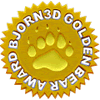
 Bjorn3D.com Bjorn3d.com – Satisfying Your Daily Tech Cravings Since 1996
Bjorn3D.com Bjorn3d.com – Satisfying Your Daily Tech Cravings Since 1996














